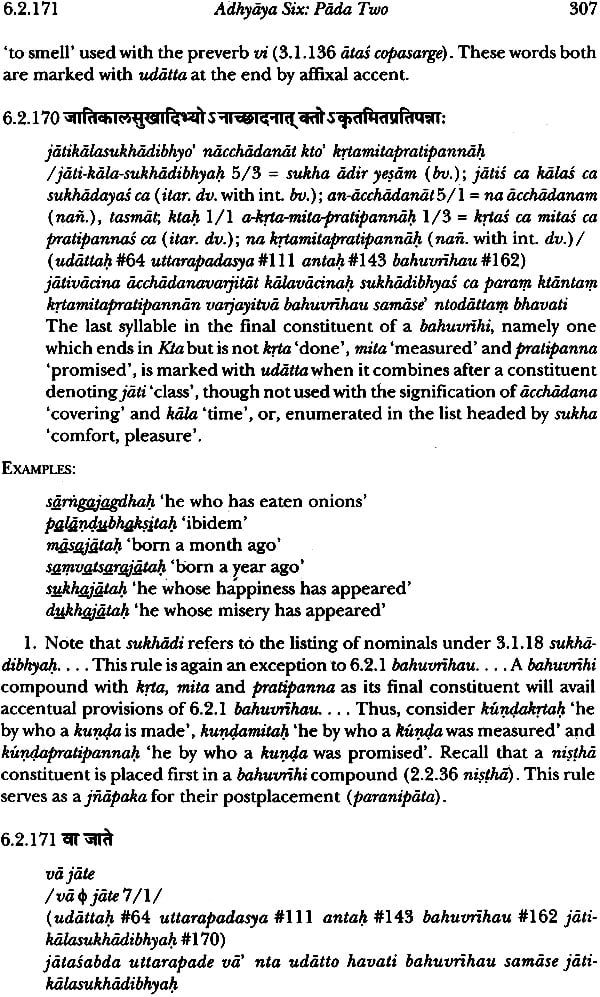
The Astadhyayi of Panini - Volume V (English Translation of Adhyaya Six with Sanskrit Text, Transliteration, Word-Boundary, Anuvrtti, Vrtti, Explanatory Notes, Derivational History of Examples, and Indices.)
Book Specification
| Item Code: | IDE113 |
| Author: | Rama Nath Sharma |
| Publisher: | MUNSHIRAM MANOHARLAL PUBLISHERS PVT LTD |
| Language: | English |
| Edition: | 2001 |
| ISBN: | 9788121509626 |
| Pages: | 614 |
| Cover: | Hardcover |
| Other Details | 9.8" X 6.8" |
| Weight | 1.04 kg |
Book Description
This volume of the Astadhyayi of Panini contains English translation of adhyaya six. It includes Sanskrit text of individual sutras with their transliteration, word-boundaries, indication of inflectional endings and formation of compounds. Each sutra is also furnished with anuvrtti, vrtti, examples, detailed explanatory notes and complete derivational history of examples cited by the Kasikavrtti.
Explanatory notes are presented to facilitate proper understanding of individual sutras, especially in view of their formulation, interpretation, application and relative placement. An attempt has been made to sort out and explain pertinent issues, as raised and discussed by major commentaries. The appendix contains major derivations, in addition to nearly five hundred derivations discussed in the text under individual sutras.
This volume is the fifth of a planned six-volume study. The sixth, and the last volume, of the series will cover the sutras of adhyayas seven and eight.
Rama Nath Sharma is Professor of Sanskrit at the University of Hawaii at Manoa, Honolulu, Hawaii, USA. He received his Ph. D. (1971) in General Linguistics from the University of Rochester where he also taught Linguistics for five years. His research interest includes grammatical theory in general, and Panini and the Indian grammatical tradition, in particular.
I have, as usual, relied very heavily on commentarial sources for sorting out issues relative to rule-formulation, interpretation, application and order. Three prakriyii texts, the Rupavatarah. of Dharmakirti, the Prakriyakaumudi of Ramacandra and the Siddhantakamudi of Bhattoji Diksita have served as primary sources for derivational details. I have benefited most from the Vyakarana-mahabhasya of Patanjali, the Vyakarana-candrodaya of Charudeva Shastri, the Kasikavrtti with the commentaries Nyasa of Jinendrabuddhi and Padamafijari of Haradatta (with Hindi translation of Jayashankar Lal Tripathi), the Astadhyayi-bhasya of Prajna Devi, the Hindi translation of the Laghukaumudi of Varadaraja made by Bhimsen Shastri and the Siddhanta- kaumudi of Bhattoji Diksita with the Tattvabodhini of Jiianendra Saraswati and the Balamanorama of Vasudeva Diksita. I have mostly followed the Kasikavrtti with the Nyasa and Padamanjari for explanatory notes. Nyasa, Padamaiijari and Siddhantakaumudi have proved extremely valuable in clari- fying issues relative to rule interaction and conflict resolution. Here again, under individual rules, I have taken detours to accomodate remarks of cul- tural importance.
I have presented some general derivational processes at the beginning of the appendix so that repetition can be minimized. I have still offered major derivational details to illustrate issues, mostly in the text but also in the appendix. Frequent references to derivational details of earlier volumes have proved very helpful. I have, at places, found accentual rule-interaction some- what puzzling. My reader must remain on guard in deciding issues pertaining to accentuation.
I fully realize the extremely complex nature of the form and content of the Astadhyayi. I am also aware of my own limitations due to which I may have made many mistakes. I realize that there are many typographical errors in the earlier volumes. I have tried not to repeat them in this volume. As I get closer to the completion of my last volume I feel much confident in presenting the complexity of issues based on explanatory details of com- mentaries. It also reinforces my belief that Kasika, with the Nyasa and ,Padamanjari, is the best source for fully understanding intricacies of the Astadhyayi. I have already started preparing a more detailed version of volume one and do intend to edit volumes two and three. I shall greatly appreciate my reader's comments in this regard.
I must express my deep sense of indebtedness to authors of works I have regularly consulted. My brother Narendra and Pandit Ramaprasad Tripathi, both of the Sampurnanand Sanskrit University at Varanasi, have always been generous to me in giving of their time. I dedicate this volume in memory of Pandit Ramaprasad Tripathi who recently passed away. I had the honor of studying the entire Kasikavrtti with its commentaries Nyasa and Padamanjari with him. I have, as usual, greatly benefited from the writings of Professor George Cardona.
The University of Hawaii, especially through its Research Council and Research Relations, has been very generous in supporting my research endeavors with grants. The American Institute of Indian Studies still remains the major funding agency to support this entire project. I must express my special thanks to Chris Bopp without whose programming skills I could never find my way out of the software jungle. These volumes owe a great deal to him. These volumes owe the most to my wife Kamala who has always protected me from many of my duties as a householder. I could not do this project without her support. Finally, I must thank Mr. Devendra Jain, Director of Munshiram Manoharlal Publishers, my publishers, in dealing with this often not-so-very organized Pandit.
| Preface | ix |
| Abbreviations | xi |
| Adhyaya Six | 1 |
| Appendix | |
| Derivational History of Examples | 567 |
| Bibliography | 582 |
| Index of Derivations | 585 |
| Index of Terms | 588 |
| Index of Sutras | 594 |


 to all international destinations within 3 to 5 days, fully insured.
to all international destinations within 3 to 5 days, fully insured.




